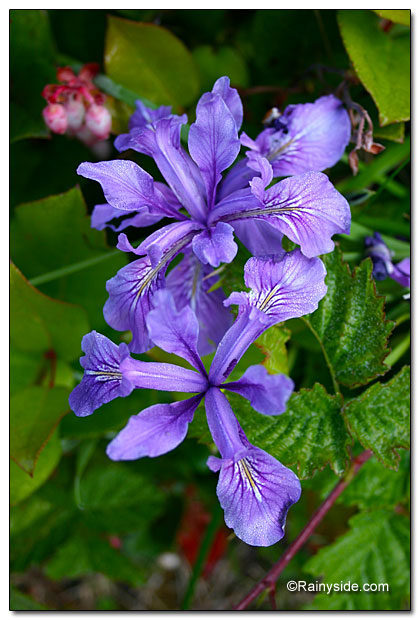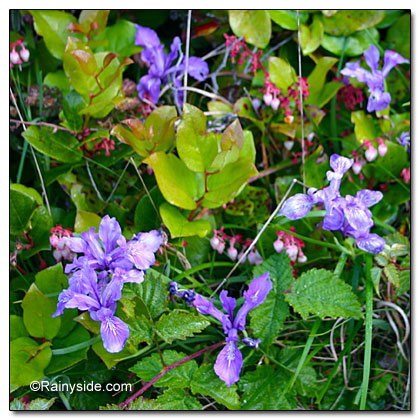Iris tenax
TOUGH-LEAVED IRIS, TOUGHLEAF IRIS, OREGON IRIS, OREGON FLAG
Family: Iridaceae
Pronounced: EYE-ris TEN-aks

Quick Jumps
Growing Guide
Rainy Side Notes
GROWING GUIDE

Origin:
Western Oregon, Western Washington, and Northern California.
Plant Group:
Perennials.
Hardiness:
Sunset zones: Not listed.
USDA zones: 5-9.
Heat zones: 9-5.
Mature size:
Height: 8-14 inches (20-35 cm.)
Flowering period:
Mid-spring to midsummer, some years as early as late March.
Flowering attributes:
Lavender is the predominate color, but some flowers can be purple to purple-blue, pink, yellow and even white. It normally carries one flower per stalk, sometimes two.
Leaf attributes:
Deciduous, grass-like blades no more than ¼-inch wide, bright green leaves.
Light:
Dappled shade, partial shade to full sun.
Soil:
Moist, humus rich soil but can tolerate dry soil.
Propagation Methods:
Sow fresh seed immediately, or store seed in dry, cool conditions to sow later, fall being preferable.
Divide rhizomes in early fall.
Pruning Methods:
N/A
Pests and Diseases:
Slugs and snails can be a problem.
Rainy Side Notes

Iris tenax tucked in with native Salal.
Iris tenax is one of the most common of the Pacific Coast Iris growing in our maritime Northwest region, and one of the prettiest. Yet its epithet tenax, which means tough, testifies to its holding power.
This fire-resistant native is widespread throughout Western Oregon, reaches up into Grays and Thurston counties in Washington, and reaches down into Northern California. Its native habitat, from low to middle elevations, consists of moist meadows, forest glades, and open areas.
A subspecies of this Northwest native is gormanii, which has pale yellow flowers and is found in Southwestern Washington.
Ethnobotany
In 1825, botanist David Douglas observed Northern Californian native people of the Tolowa tribe utilizing the subspecies—I. tenax ssp. klamenthensis—which grows in the area. Using mussel shells to scrape the strong fibers of the outer leaf margins clean, they fashioned many useful items. Braiding them, they made rope, nets, snares and bags. The snares were strong enough to hold game as large as elk. For fishing nets, the buoyant material was ideal—the nets would not sink.
In the Garden
These natives are wonderful garden plants. They can take moist as well as dry areas, but they prefer moist, humus rich soil. They live happily in dappled shade or partial shade to full sun; however, they won’t tolerate full shade. Plant them along woodland’s edge or in the garden border. Give them what they need, and they will come back year after year, slowly increasing their clump.
This species is reportedly deer and rabbit resistant, but this may depend on the local herd. I planted my own iris from seed. Although they did not flower for a few years, once in bloom, they were worth the wait.
Handle with care. Fresh or dry rhizomes and rootstocks are poisonous when ingested; in addition, the foliage and flowers may cause skin dermatitis.
A Pacific Northwest Plant of the Week (2013)

Gardening for the Homebrewer: Grow and Process Plants for Making Beer, Wine, Gruit, Cider, Perry, and More
By co-authors Debbie Teashon (Rainy Side Gardeners) and Wendy Tweton
Copyright Notice | Home | Search | Natives

